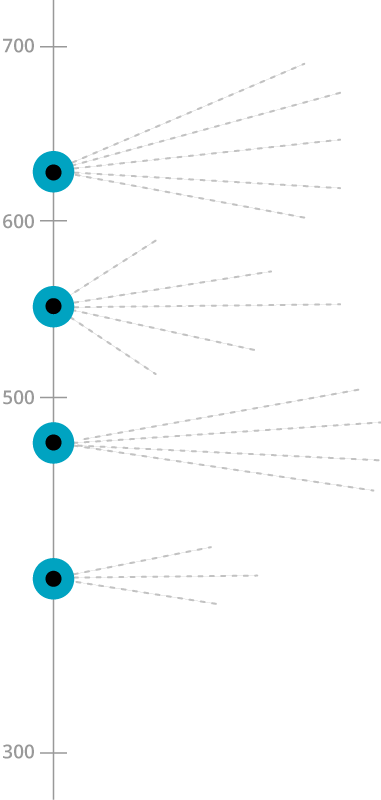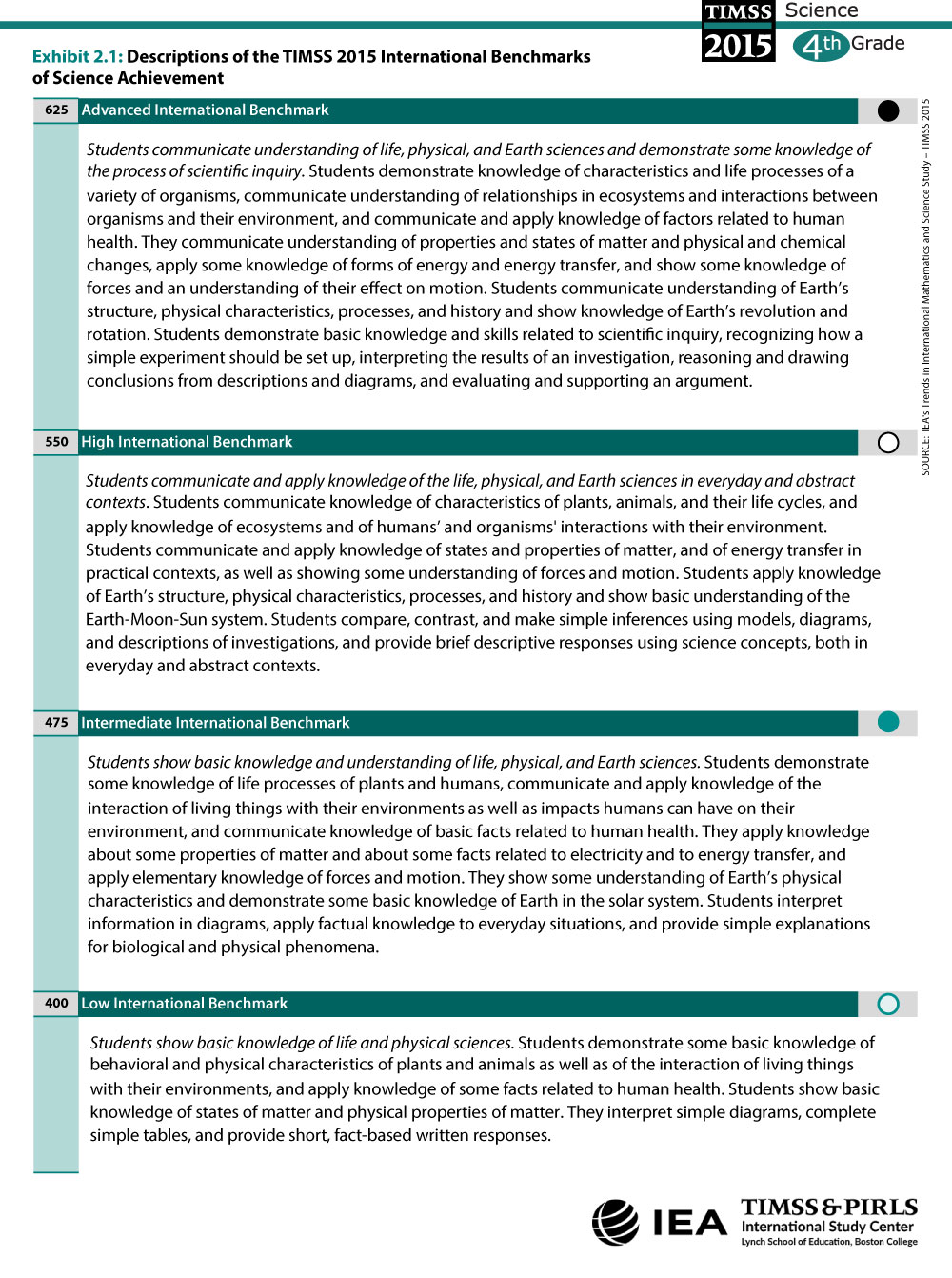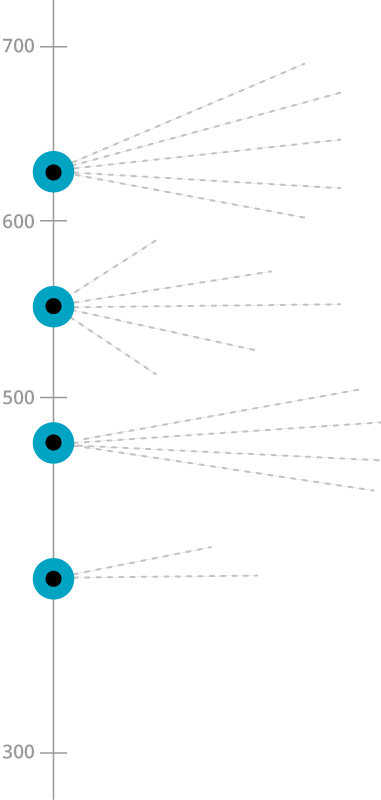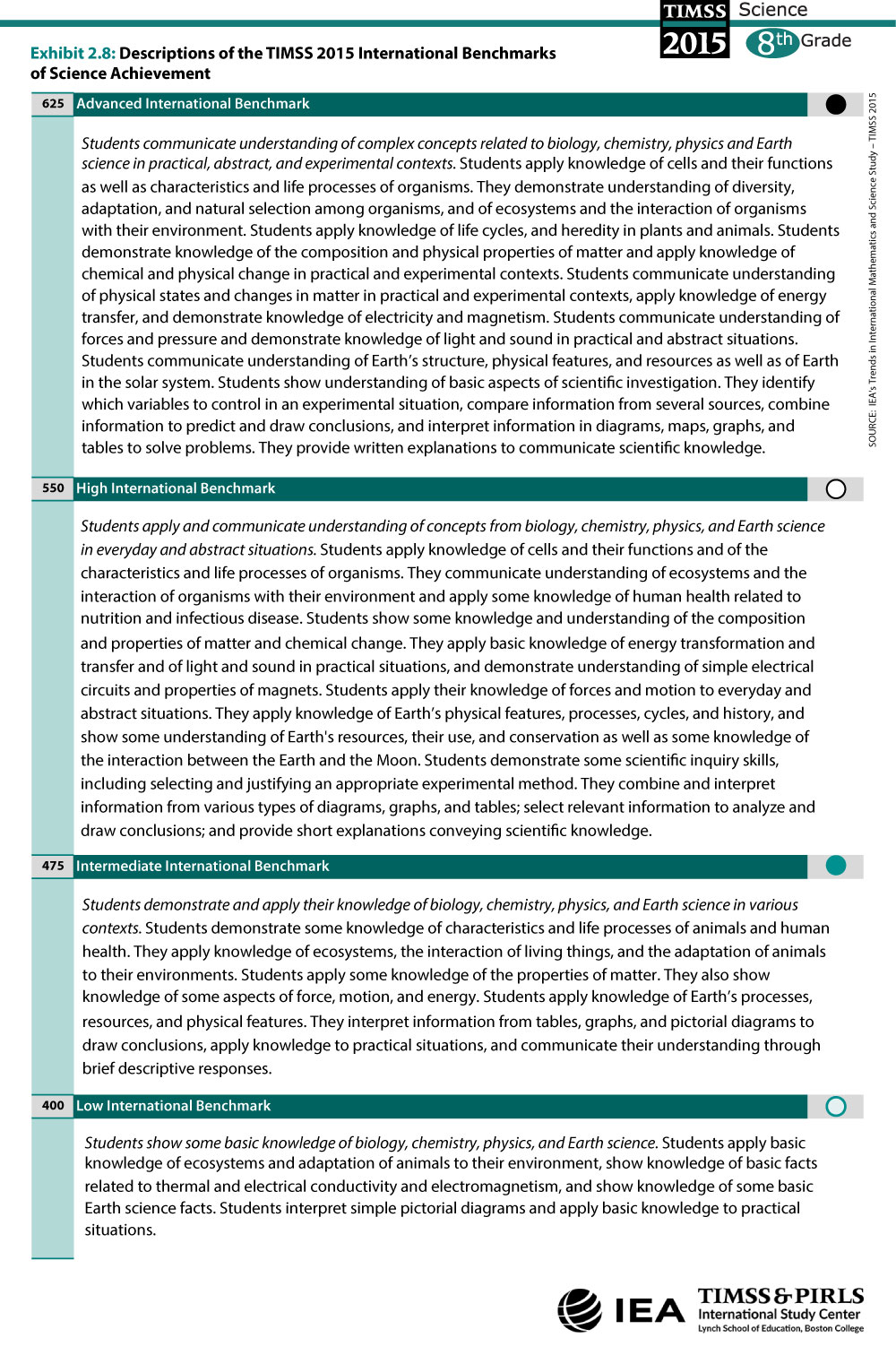TIMSS 2015 International Benchmarks of Science Achievement
As a way of interpreting the scaled achievement results, four points on the science achievement scales were identified as international benchmarks—Advanced (625), High (550), Intermediate (475), and Low (400). The TIMSS & PIRLS International Study Center worked with the TIMSS 2015 Science and Mathematics Item Review Committee (SMIRC) to conduct a detailed scale anchoring analysis to describe science achievement at the benchmarks, and to select example items to illustrate the science content and types of cognitive processing skills and strategies demonstrated by students at each of the international benchmarks. For the items designated for use in reporting the results, every effort was made to include examples that not only illustrated the particular benchmark under consideration, but also represented different item formats and content area domains.
Item Map

Students communicate understanding of life, physical, and Earth sciences and demonstrate some knowledge of the process of scientific inquiry. Students demonstrate knowledge of characteristics and life processes of a variety of organisms, communicate understanding of relationships in ecosystems and interactions between organisms and their environment, and communicate and apply knowledge of factors related to human health. They communicate understanding of properties and states of matter and physical and chemical changes, apply some knowledge of forms of energy and energy transfer, and show some knowledge of forces and an understanding of their effect on motion. Students communicate understanding of Earth’s structure, physical characteristics, processes, and history and show knowledge of Earth’s revolution and rotation. Students demonstrate basic knowledge and skills related to scientific inquiry, recognizing how a simple experiment should be set up, interpreting the results of an investigation, reasoning and drawing conclusions from descriptions and diagrams, and evaluating and supporting an argument.
More about this benchmark
Students communicate and apply knowledge of the life, physical, and Earth sciences in everyday and abstract contexts. Students communicate knowledge of characteristics of plants, animals, and their life cycles, and apply knowledge of ecosystems and of humans’ and organisms’ interactions with their environment. Students communicate and apply knowledge of states and properties of matter, and of energy transfer in practical contexts, as well as showing some understanding of forces and motion. Students apply knowledge of Earth’s structure, physical characteristics, processes, and history and show basic understanding of the Earth-Moon-Sun system. Students compare, contrast, and make simple inferences using models, diagrams, and descriptions of investigations, and provide brief descriptive responses using science concepts, both in everyday and abstract contexts.
More about this benchmark
Students show basic knowledge and understanding of life, physical, and Earth sciences. Students demonstrate some knowledge of life processes of plants and humans, communicate and apply knowledge of the interaction of living things with their environments as well as impacts humans can have on their environment, and communicate knowledge of basic facts related to human health. They apply knowledge about some properties of matter and about some facts related to electricity and to energy transfer, and apply elementary knowledge of forces and motion. They show some understanding of Earth’s physical characteristics and demonstrate some basic knowledge of Earth in the solar system. Students interpret information in diagrams, apply factual knowledge to everyday situations, and provide simple explanations for biological and physical phenomena.
More about this benchmark
Students show basic knowledge of life and physical sciences. Students demonstrate some basic knowledge of behavioral and physical characteristics of plants and animals as well as of the interaction of living things with their environments, and apply knowledge of some facts related to human health. Students show basic knowledge of states of matter and physical properties of matter. They interpret simple diagrams, complete simple tables, and provide short, fact-based written responses.
More about this benchmark

Analyzes statements to identify possible characteristics of predators and prey
More about this item
Explains how a flu-like disease can be transmitted through the air
More about this item
Explains how the poles of two magnets should be oriented to cause repulsion
More about this item
Explains one reason why it is important to have spiders in a garden
More about this item
Identifies how having coloring similar to their surroundings helps birds stay alive
More about this item
From a diagram, identifies the orientation of the poles on two repelling magnets
More about this item
Given a list of five everyday objects, recognizes which ones conduct electricity
More about this item
From a table showing temperature and cloud cover at different locations, identifies the place where it is most likely to snow
More about this item
Uses a list of living things in a desert ecosystem to complete a food chain
More about this item
Identifies the direction of the force of Earth’s gravity in a diagram
More about this item
Completes a table by matching diagrams of animals to their ecosystems
More about this item
Summary

Item Map

Students communicate understanding of complex concepts related to biology, chemistry, physics and Earth science in practical, abstract, and experimental contexts. Students apply knowledge of cells and their functions as well as characteristics and life processes of organisms. They demonstrate understanding of diversity, adaptation, and natural selection among organisms, and of ecosystems and the interaction of organisms with their environment. Students apply knowledge of life cycles, and heredity in plants and animals. Students demonstrate knowledge of the composition and physical properties of matter and apply knowledge of chemical and physical change in practical and experimental contexts. Students communicate understanding of physical states and changes in matter in practical and experimental contexts, apply knowledge of energy transfer, and demonstrate knowledge of electricity and magnetism. Students communicate understanding of forces and pressure and demonstrate knowledge of light and sound in practical and abstract situations. Students communicate understanding of Earth’s structure, physical features, and resources as well as of Earth in the solar system. Students show understanding of basic aspects of scientific investigation. They identify which variables to control in an experimental situation, compare information from several sources, combine information to predict and draw conclusions, and interpret information in diagrams, maps, graphs, and tables to solve problems. They provide written explanations to communicate scientific knowledge.
More about this benchmark
Students apply and communicate understanding of concepts from biology, chemistry, physics, and Earth science in everyday and abstract situations. Students apply knowledge of cells and their functions and of the characteristics and life processes of organisms. They communicate understanding of ecosystems and the interaction of organisms with their environment and apply some knowledge of human health related to nutrition and infectious disease. Students show some knowledge and understanding of the composition and properties of matter and chemical change. They apply basic knowledge of energy transformation and transfer and of light and sound in practical situations, and demonstrate understanding of simple electrical circuits and properties of magnets. Students apply their knowledge of forces and motion to everyday and abstract situations. They apply knowledge of Earth’s physical features, processes, cycles, and history, and show some understanding of Earth’s resources, their use, and conservation as well as some knowledge of the interaction between the Earth and the Moon. Students demonstrate some scientific inquiry skills, including selecting and justifying an appropriate experimental method. They combine and interpret information from various types of diagrams, graphs, and tables; select relevant information to analyze and draw conclusions; and provide short explanations conveying scientific knowledge.
More about this benchmark
Students demonstrate and apply their knowledge of biology, chemistry, physics, and Earth science in various contexts. Students demonstrate some knowledge of characteristics and life processes of animals and human health. They apply knowledge of ecosystems, the interaction of living things, and the adaptation of animals to their environments. Students apply some knowledge of the properties of matter. They also show knowledge of some aspects of force, motion, and energy. Students apply knowledge of Earth’s processes, resources, and physical features. They interpret information from tables, graphs, and pictorial diagrams to draw conclusions, apply knowledge to practical situations, and communicate their understanding through brief descriptive responses.
More about this benchmark
Students show some basic knowledge of biology, chemistry, physics, and Earth science. Students apply basic knowledge of ecosystems and adaptation of animals to their environment, show knowledge of basic facts related to thermal and electrical conductivity and electromagnetism, and show knowledge of some basic Earth science facts. Students interpret simple pictorial diagrams and apply basic knowledge to practical situations.
More about this benchmark

In the context of an investigation about cellular respiration, identifies the gas produced and its source
More about this item
Determines the color that results after a pH indicator is added to four solutions, based on information provided about the indicator
More about this item
Recognizes whether characteristics of substances are physical or chemical properties
More about this item
Interprets a diagram to describe the direction of heat flow in metals
More about this item
Draws an arrow on a map to show the direction a river flows and explains why it flows in this direction
More about this item
Explains why birds of prey cannot survive in an environment without plants
More about this item
Identifies and explains which solution is more dilute than another in a given context
More about this item
Explains whether a conclusion can be made about the relative strength of two magnets in a given context
More about this item
Recognizes a consequence of the gravitational pull of the Moon on Earth
More about this item
Explains the advantage for a species of mice to have coloring matching its environment
More about this item
Uses information from an investigation to recognize the condition under which nails would rust most
More about this item
Recognizes a material that best conducts both heat and electricity
More about this item
Using a diagram, identifies what moves water from an artesian basin to the surface
More about this item
Summary

